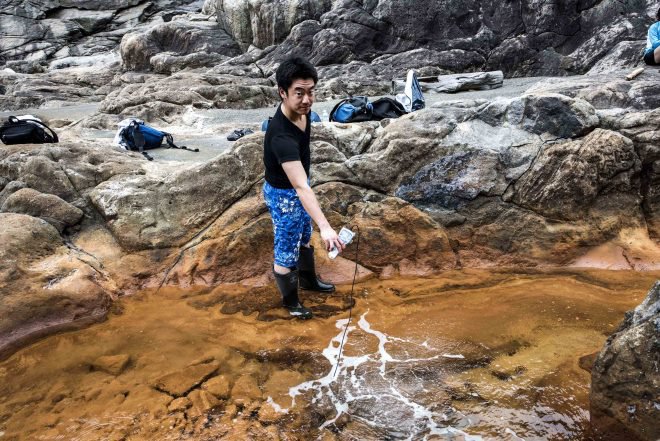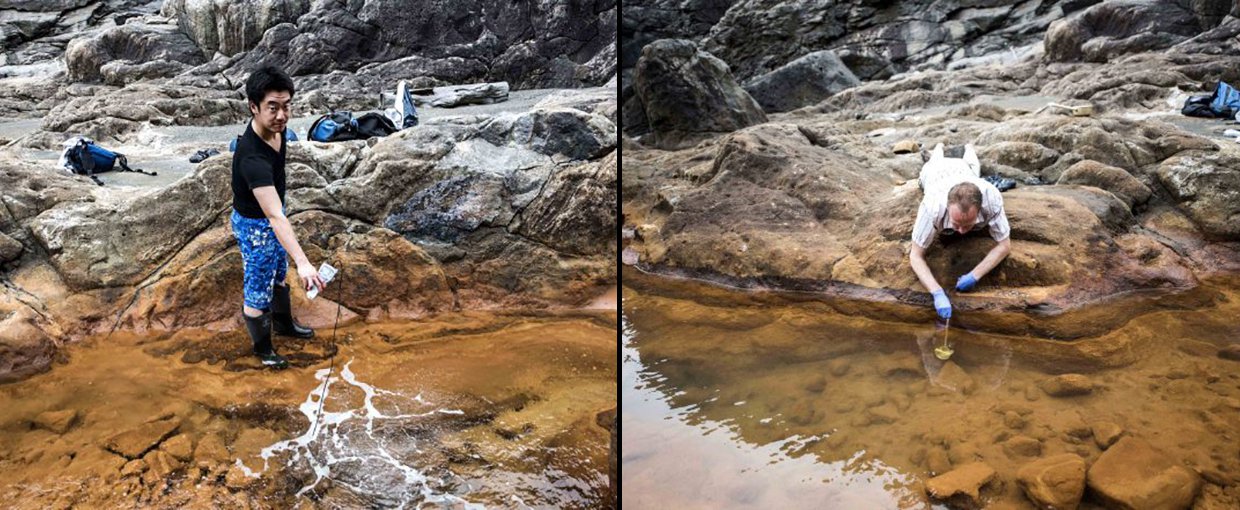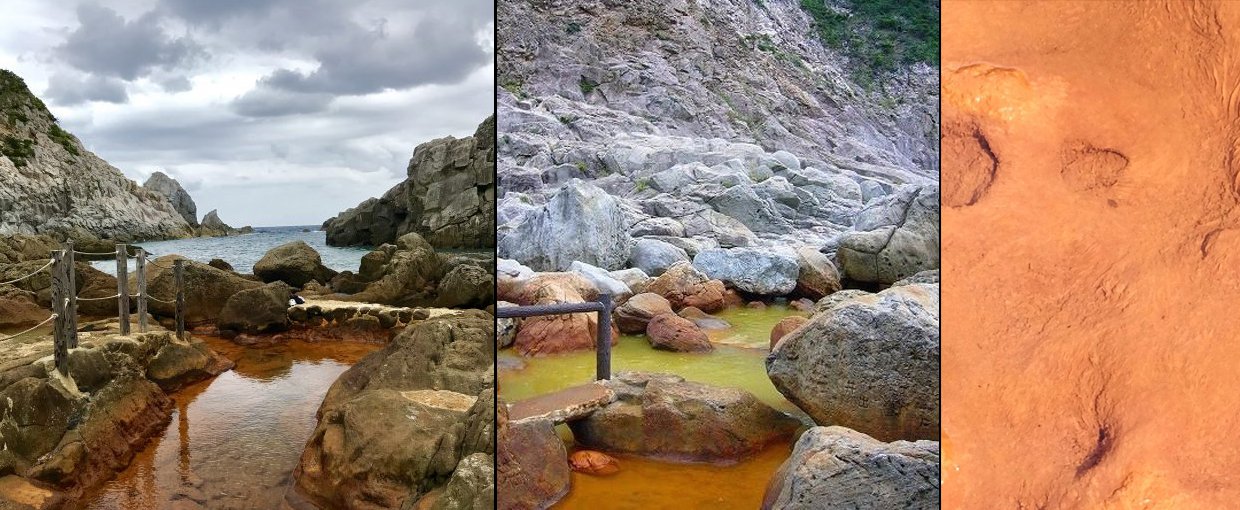
Along the edge of an inlet on a tiny Japanese island can be found– side by side – striking examples of conditions on Earth some 2.4 billion years ago, then 1.4 billion years ago and then the Philippine Sea of today.
First is a small channel with iron red, steaming and largely oxygen-free water – filled from below with bubbling liquid above 160 degrees F. This was Earth as it would have existed, in a general way, as oxygen was becoming more prevalent on our planet some 2.4 billion years ago. Microbes exist, but life is spare at best.

Scalding hot water from an underground thermal spring creates an iron-rich environment similar to what existed on Earth 2.5 billion years ago.Image credit: Nerissa Escanlar.
Right next to this ancient scene is region of green-red water filled with cyanobacteria – the single-cell creatures that helped bring masses of oxygen into our atmosphere and oceans. Locals come to this natural “onsen” for traditional hot baths, but they have to make their way carefully because the rocky floor is slippery with green mats of the bacteria.
And then there is the Philippine Sea, cool but with spurts of warm water shooting up from below into the cove.
All of this within a area of maybe 100 square feet.
It is a unique hydrothermal scene, and one recently studied by two researchers from the Earth-Life Science Institute in Tokyo – evolutionary microbiologist Shawn McGlynn and ancient virus specialist Tomohiro Mochizuki.
They were taking measurements of temperature, salinity and more, as well as samples of the hot gas and of microbial life in the iron-red water. Cyanobacterial mats are collected in the greener water, along with other visible microbe worlds.
The scientific goals are to answer specific questions – are the bubbles the results of biology or of geochemical processes? What are the isotopic signatures of the gases? What microbes and viruses live in the super-hot sections? And can cyanobacteria and iron co-exist?
All are connected, though, within the broad scientific effort underway to ever more specifically understand conditions on Earth through the eons, and how those conditions can help answer fundamental questions of how life might have begun.

Shawn McGlynn, associate professor at the Earth Life Science Institute in Tokyo scoops some iron-rich water from a channel on Shikine-jima Island, 100 miles from Tokyo.Image credit: Nerissa Escanlar.
“We really don’t know what microbiology looked like 2.5 billion or 1.5 billion years ago,” said McGlynn, “But this is a place we can go where we can try to find out. It’s a remarkable site for going back in time.”
In particular, there are not many natural environments with high levels of dissolved iron like this site. Yet scientists know from the rock record that there were periods of Earth history when the oceans were similarly filled with iron.
Mochizuki elaborated: “We’re trying to figure out what was possible chemically and biologically under certain conditions long ago.
“If you have something happening now at this unusual place – with the oxygen and iron mixing in the hot water to turn the water red – then there’s a chance that what we find today was there as well billions of years ago. ”
The Jinata hot springs, as the area is known, is on Shikine-jima Island, one of the furthest out in the Izu chain of islands that starts in Tokyo Bay. More than 100 miles from Tokyo itself, Shikine-jima is nonetheless part of Tokyo Prefecture.
The Izu islands are all volcanic, created by the underwater movements of the Philippine and Pacific tectonic plates. That boundary remains in flux, and thus the hot springs and volcanoes. The terrain can be pretty rugged: in English, Jinata translates to something like Earth Hatchet, since the hot spring is at the end of a path through what does look like a rock rising that had been cut through with a hatchet.

Tomohiro Mochizuki at collecting samples directly from the spot where 160 degree F water pushes up through the rock at Jinata hot spring.Image credit: Nerissa Escanlar.
Hot springs and underwater thermal vents have loomed large in thinking about origins of life since it became known in recent decades that both generally support abundant life – microbial and larger – and supply nutrients and even energy in the form of electricity from vents and electron transfers from chemical reactions.
And so not surprisingly, vents are visited and sampled not infrequently by ELSI scientists. McGlynn was on another hydrothermal vent field trip in Iceland over the summer with, among others, ELSI Origins Network fellow Donato Gionovelli and ELSI principal investigator and electrochemist Ruyhei Nakamura..
McGlynn’s work is focused on how electrons flow between elements and compounds, a transfer that he sees as a basic architecture for all life. With so many compelling flows occurring in such a small space, Jinata is a superb laboratory.
For Mochizuki, the site turned out to be exciting but definitely not a goldmine. That’s because his speciality is viruses that live at very high temperatures, and even the bubbling hot spring in the iron trench measured about 73 degrees C (163 degrees F.) The viruses he incubates live at temperatures between closer to 90 C (194 F), not far from the boiling point.
His goal in studying these high-temperature (hyperthermophilic) viruses is to look back to the earliest days of life forming on Earth, using viruses as his navigators. Since life is thought by many scientists to have begun in a super hot RNA world, Mochizuki wants to look at viruses still living in those conditions today to see what they can tell us.
So far, he explained, what they have told us is that the RNA in the earliest lifeforms on Earth – denizens of the Archaean kingdom – did not have viruses. And this is puzzling.
So Mochizuki is always interested in going to sample hot springs and thermal vents to collect high temperature viruses, and to look for surprises.
Though the bubbling waters were so hot that both researchers had difficulty standing in the water with boots on and holding their collection vials with gloves, it was not hot enough for what Mochizuki is after. But that certainly didn’t stop him from taking as many samples as he could, including some for other ELSI researchers doing different work but still needing interesting samples.

The volcanic Izu island chain, starting in Tokyo Bay and going out into the Philippine Sea.
Researchers often need to be inventive on field trips, and that was certainly the case at Jinata. When McGlynn first tried to sample the bubbles at the scalding spring, his hands and feet quickly felt on fire and he had to retreat.
To speed the process, he and Mochizuki built a funnel out of a large plastic water bottle, a device that allowed the bubbles to be collected and directed into the sample vial without the gloved hands being so close to the heat. The booted feet, however, remained a problem and the heat just had to be endured.
Nearby the steaming bubbling of the hot spring were collections of what appeared to be fine etchings on the bottom of the red channel. These faint designs, McGlynn explained, were the product of a microbe that makes it’s way along the bottom and deposits lines of processed iron oxide as it goes. So while the elegant designs are not organic, the creatures that creates them surely is.
“Touch the area and the lines go poof,” McGlynn said. “That’s because they’re just the iron oxide; nothing more. Next to us is the water with much less iron and a lot more oxygen, and so there are blooms of (green) cyanobacteria. Touch them and they don’t go poof, they stick to your hand because they’re alive.”

Filaments created by microbes as they deposit iron oxide at the bottom of small channel.Image credit: Marc Kaufman.
McGlynn also collects some of the the poofs to get at the microbes making the unusual etchings. It may be a microbe never identified before.
As a microbiologist, he is of course interested in identifying and classifying microbes. He initially thought the microbes in the iron channel would be anaerobic, but he found that even tiny amount of oxygen making their way into the springs from the atmosphere made most aerobic, or possibly anaerobes capable of surviving with oxygen (which usually is toxic to them.)
He also found that laboratory studies that found cyanobacteria would not flourish in the presence of iron were not accurate in nature, or certainly were not accurate at Jinata onsen.
But it is that flow of electrons that really drives McGlynn – he even dreams of them at night, he told me.
One of the goals of his work, and that of his colleague and sometimes collaborator at ELSI, geobiochemist Yuichiro Ueno, is to answer some of the outstanding questions about that flow of electrons (electricity) from the core of the Earth. The energy transits through the mantle, to the surface and then often is in contact with the biosphere (all living things) before it enters the atmosphere and sometimes disappears into space.
He likened the process to the workings of a gigantic battery, with the iron core as the cathode and the oxygen in the atmosphere as the anode. Understanding the chemical pathways traveled by the electrons today, he is convinced, will tell a great deal about conditions on the early Earth as well.
It’s all important research in what is a chipping away of the many unknowns in the stories of the origins of Earth and the origin of life.

A boundary between where the very hot iron-rich water meets and the less hot water with thriving cyanobacteria colonies at Jinata.Image credit: Nerissa Escanlar.
The field work also illustrated the hit-and-miss nature of these kind of outings. While McGlynn has not come up with Jinata surprises or novel understandings, he was so taken with the setting that he wondered if a seemly empty building not too far from the site could be turned into an ELSI marine lab.
And while Mochizuki did not find sufficiently hot water for his work, he might still be coming back to the island, or others nearby. That’s because he learned of a potentially much hotter spring at a spot where the sea hits one of the island’s steep cliffs – a site that requires boat access that was unsafe in the choppy waters during this particular visit.
In addition, McGlynn and Mochizuki did make some surprising discoveries, though they didn’t involve microbes, electron transfer or viruses.
During a morning visit to a different hot spring, they came across a team of what turned out to be officials of the Izu islands – all dressed in suits and ties. They were visiting Shikine-jima as part of a series of joint islands visit to assess economic development opportunities.
The officials were intrigued to learn what the scientists were up to, and made some suggestions of other spots to sample. One was an island occupied by Japanese self-defense forces and generally closed to outsiders. But the island is known to have areas of extremely hot water just below the surface of the land, sometimes up to 100 C (212 F.)
The officials gave their cards and told the scientists to contact them if they wanted to get onto that island for sampling. And as for the official from Shikine-jima, he was already thinking big.
“It would be a very good thing,” he said, “if you found the origin of life on our island.


